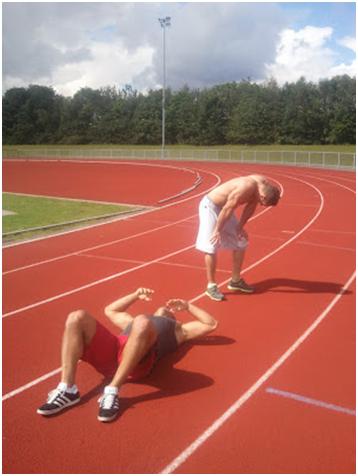I have always believed sprinting to be one of the best conditioning tools available to any athlete involved in a high intensity sport. BJJ and MMA luminaries like George St Pierre, BJ penn and Roger Gracie all have documented usage of sprints in their conditioning approach. Don’t take my word for it, the science stacks up too. A group of scientists late last year decided to apply a similar protocol to trained wrestlers. The Sprint Interval Training (SIT) consisted of 6 35-m sprints at maximum effort with a 10-second recovery between each sprint. The SIT protocol was performed in 2 sessions per week, for the 4 weeks. The SIT subjects did everything else the same as the control group, their training consisted of learning and drilling technique, live wrestling and weight training for 4 weeks. The subjects experienced an increase in VO2 max (5.4%) and a increase in testosterone and decrease in cortisol.
In another study on elite level Korean Judo athletes undertook sprint interval training with 30 second sprints and 4 minutes rest. The results were compelling “anaerobic peak power and mean power in SIT group was significantly increased by 16% and 17% at 4 weeks and by 17% and 22% at 8 weeks compared to baseline values.” Additionally the blood lactate was lower and ability to clear metabolites was higher in those who did SIT. Jens Bangsbo performed a study in 2009 showing that if you want to run, cycle or swim faster at any distance, you have to train at a pace that is almost as fast as you can move. In 2005 and 2006 Burgomaster et al performed studies looking at the effect of sprint training on endurance. They concluded that short sprint interval training (approximately 15 min of intense exercise over 2 wk period) increased muscle oxidative potential and doubled endurance capacity during intense aerobic cycling in recreationally active individuals. In 2005 Gibala reported that 30 second bursts working at 250% of VO2 max had significant improvements on endurance.
So what explains these changes in performance? Well SIT style training sets the stage for improvement in the long term by improving the capacity of the trainees mitochondria (these generate ATP) to handle / utilise nutrients, also with an increase in GLUT-4 activity (GLUT4 is the insulin-regulated glucose transporter) indicating a profoundly increased capacity for glucose uptake and we can also see a +20% increase in citrate synthase activity, indicating an increased capacity for substrate oxidation (energy usage). An additional increase in citrate synthase means higher turnover of the Krebs cycle (the cycle that allow us to generate energy).
Now before you blow the dust off your biology text books, you can take my word for it too. I have run the same protocal as the korean judo study and seen decreases in resting heart rate and improvements in power output of 15-23%. We will run a cycle of sprints from 4-8 weeks generally during a general conditioning phase or the first 8 weeks of a 16 week pre fight.
You are probably wondering how to apply the method to your own training. Well with sprint training you can make gains with as little as twice a week with very few intervals. The intensity needs to be high, each sprint you should be putting in an honest 100% effort with every attempt. Sprints are hard and by the 4th or 5th interval you will be wondering why you thought it was a good idea. Fitness battles are never won by seeking comfort.
In terms of number of sprints generally aim for between 4-8 intervals with 2-4 minutes rest. Sprints should be between 20-30 seconds worth of 100% intensity work. This can be done on a track or on a rower or on a bike if you have the right kind of exercise bike with reasonable resistance. Track sprints tend to leave you with soreness in the hip flexors, quads and glutes where as cycling tends to really hammer the quads. One observation is that track sprinting appears to be stressful in terms of soft tissue injury, a 2012 study released just in feb confirmed my suspicions. For this reason I prefer rowing to cycling and track sprinting, after-all its the effort not the method that is important, so consider this when approaching your planning. Personally I like the rower or bike as this allows us to track power output in watts (some bikes can do this too), with the athlete trying to put in the highest wattage every sprint and beat bests from week to week. A good beginner set up is a follows.
Warm-up sprints 50%, 70%, 80% followed by 6 Sprints 2-3:30 rest between sprints.
If you where planning on being the next Usian bolt or Yohan blake, complete recovery would be needed. However we are pushing to build tolerance to metabolites so you become more accomplished you can begin to cut down rest periods. So with a bevy of benefits it is well worth adding sprints to your conditioning plan.
This is an ongoing series of articles from guest blogger and Strength & Conditioning coach William Wayland of Powering Through.
